We Tried 5 Methods for Cleaning Stained Glass Coffee Pots — and the Winner Was Ridiculously Effective
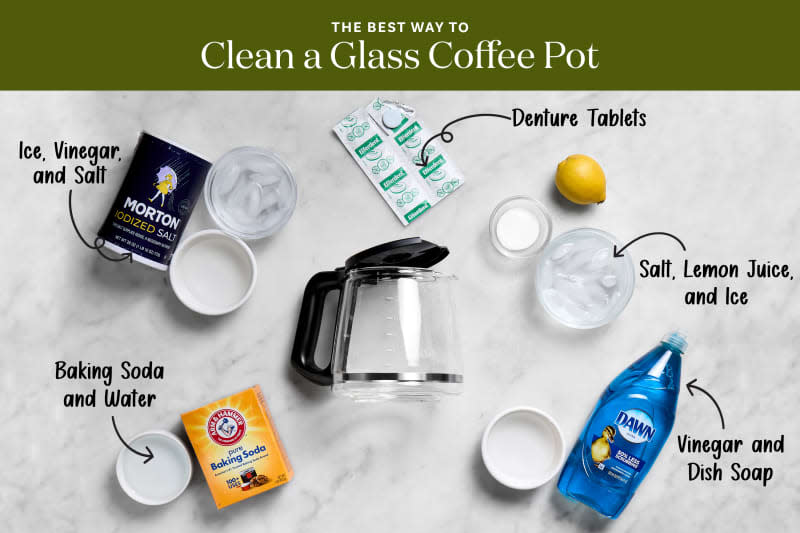
There’s nothing like the first sip of coffee on an early morning to awaken your senses and jump-start your day. Whether you take it black, iced, with a splash of creamer, or even with butter (I’m a half-and-half gal myself), coffee lovers know that no matter how diligently you rinse the pot, it’s only a matter of time before it’s seemingly permanently stained. Once they’re there, those brown and white clouds and stripes can be hard to get rid of.
When you’re dealing with glass, there’s no hiding the unsightly stains delivered by your morning joe. And if your coffeemaker sits out on your kitchen counter, you already know that cloudy coffee pots can be quite the eyesore. That’s why we tested five popular methods for cleaning coffee buildup stains out of your glass pot to find the very best solution. And, good news: The winner is probably sitting in your kitchen as we speak.
Combine 3 tablespoons of salt, 2 tablespoons of fresh lemon juice, and 1 cup of crushed ice in your carafe. Stir it around the sides for about a minute. Rinse with cold water and scrub any stubborn spots with a brush or sponge.
How We Tested the Methods to Clean Stained Glass Coffee Pots
To test coffee pot-cleaning methods, I had four different writers (including myself) test the different methods on their coffee pots, because it takes some time to get a coffee pot dirty (although experts recommend cleaning it weekly with regular use). The popular coffee pot cleaning methods we tested were: iodized salt, white vinegar, and ice; baking soda paste; white vinegar and dish soap; denture tablets; and salt, lemon juice, and ice. These are the questions I asked each of my researchers:
How well did this method work?
What would you rate this method on a scale of 1 to 5?
How long did it take from start to finish, and what was the “active” cleaning time?
How difficult/labor intensive was the process?
What was left behind in your coffee pot after finishing the method?
Were there any undesirable fumes?
Would you recommend this method, or do it again in the future?
The Ratings
To compare methods, we rated them based on how easy they were to use, how well they worked, how long they took relative to the other methods (a high score means less time), and overall. Each component is rated on a 1 to 5 scale, with 1 being the worst. Here’s how the testing went!
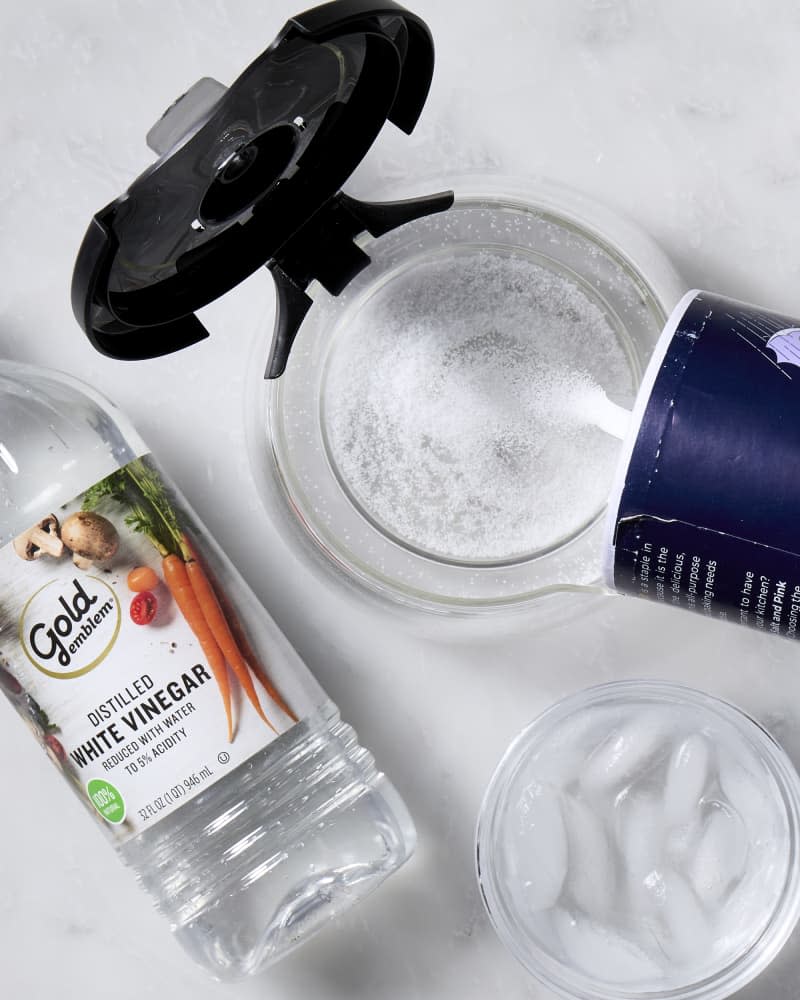
Coffee Pot Cleaning Method: Salt, Ice & Vinegar
Ease of use: 2/5
Performance: 3/5
Total time: 4/5
Overall: 2.5/5
The method: Pour about 4 tablespoons of iodized salt into the bottom of the empty carafe and top it with one scoop of ice. Add a splash of distilled white vinegar and swirl the ice in circles around the pot for about a minute. (This writer’s grandmother has sworn by the method for decades.)
How it went: I went heavy with the portions — about 8 ounces of ice and ⅓ cup of white vinegar — to really test out the abrasive capabilities of the ice pushing the salt against the glass. After I swirled the mixture around, I also tilted the vessel so the liquid could coat the upper portions of the pot. When I dumped out the solution, it was obvious from its color that the mixture had lifted some residue, but I still had to exert plenty of effort scrubbing the inside with a paper towel and then rinsing for more of the stains to be removed.
This method took a total of 5 minutes, with only 3 minutes of active cleaning time, so it’s great if you’re in a hurry — but I can’t say it was extremely effective. I knew it was cleaner than it looked, so it wasn’t entirely without value. The biggest disappointment was that relative to the elbow grease put in, the outcome wasn’t as pristine as I had hoped. While most of the brown spots were now gone (hooray!), it was still a little bit cloudy in places (boo).
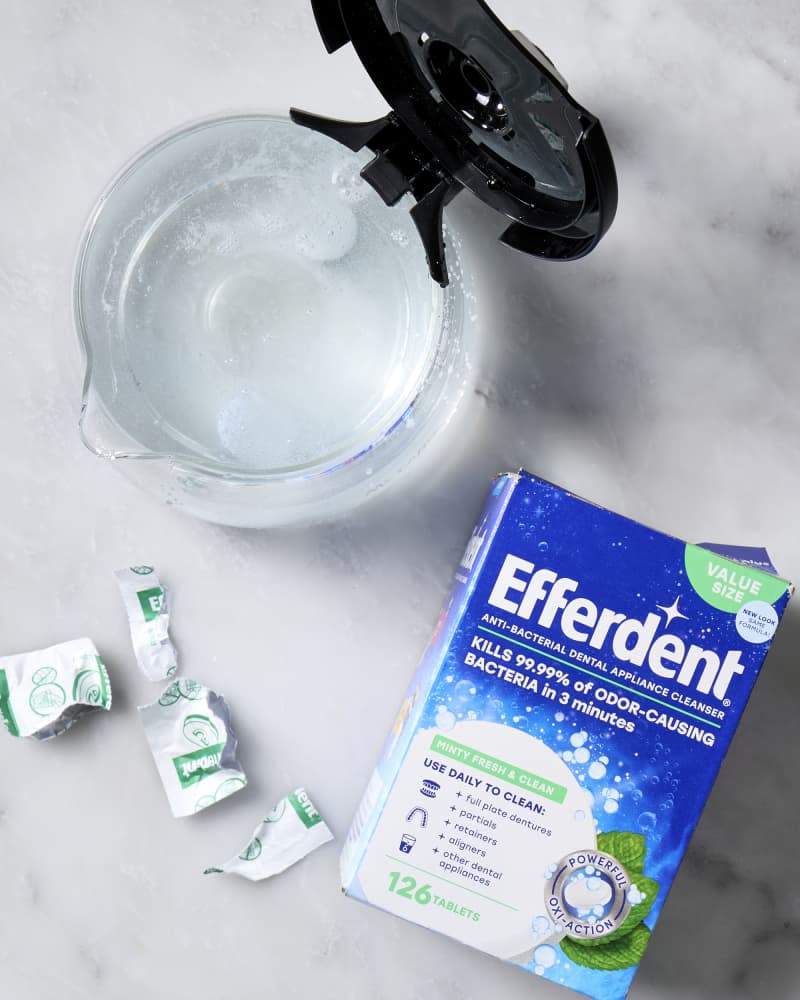
Coffee Pot Cleaning Method: Denture Tablets
Ease of use: 5/5
Performance: 3.5/5
Total time: 4/5
Overall: 4/5
The method: Fill your carafe with warm water and drop two denture tablets in. Let it sit for 15 minutes, then scrub and rinse the pot.
How it went: I loved this method! Talk about zero-effort. I opted for Efferdent’s standard antibacterial cleanser tablets, which go for less than $6 for 126 tablets, making them about 4 cents a pop. Within seconds, the entire pot was filled with buzzing blue bubbles that swirled and fizzed for a minute or two. After I swirled my bottleneck brush around in it a bit, I saw what was left of the tablets — essentially baking soda and citric acid, which makes them surprisingly great for cleaning and odor-neutralizing — scrub away the brown bits and pieces left on the sides and bottom of the glass. Although it didn’t get the oldest, hardest stains out completely, this method was great because it was so easy, cost-effective, and honestly fun to watch. I think if I had followed it with another one of the methods (which, I know, probably defeats the purpose), it would’ve gotten every last bit.
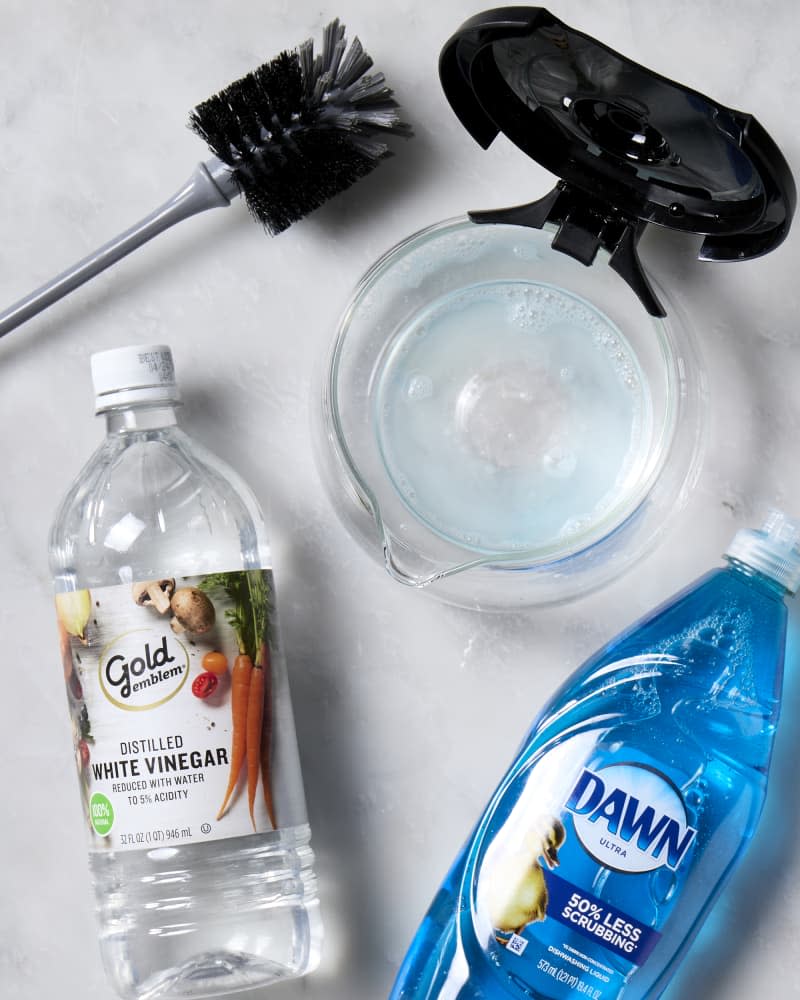
Coffee Pot Cleaning Method: Vinegar & Dish Soap
Ease of use: 4/5
Performance: 4/5
Total time: 3/5
Overall: 4/5
The method: Add equal parts warm water and distilled white vinegar to the coffee pot to fill it to the brim, then add a few drops of dish soap, and let it sit a few hours or overnight. Then, rinse.
How it went: I added three cups each of white vinegar and warm water, plus a few drops of Dawn Platinum, before letting it sit overnight. The next morning, I swirled the water around the coffee pot, emptied it, refilled it with warm water, used a long-handled bottle brush to scrub away the cloudy and dark spots, then rinsed it again and dried it with a paper towel. The paper towel swipe was all the extra effort required to restore my hardworking coffee carafe back to like-new condition.
I liked this method so much that I repeated it again the next day just to keep that pristine look. I give this method an enthusiastic 4, and here’s why: Firstly, the result was better than I expected. I went in hoping for a less brown version of what I already had, and instead received a sparkling clean result, looking almost out-of-the-box new. Second of all, I’m not one for arduous, time-consuming tasks — I loved that the result was just as good when I repeated it, without any of the waiting time. The first test involved an overnight soak and three minutes of active cleaning time; the second test included zero soaking time with the same amount of active cleaning effort. Granted, I was only cleaning one day’s coffee pot residue the second time around, but it was certainly easy (and fast) enough that I can make this part of my weekly routine. There really is no difficulty level to speak of; the “elbow grease” I put into the task was no more than it takes to load or unload a few dishes.
After this method, there is still a very scant layer of cloudiness, but you have to inspect it up close to see it. And happily, when I brewed a pot of coffee after the first cleaning, that first cup tasted just as wonderful as always, without any undesirable fumes or traces of the vinegar used to clean it.
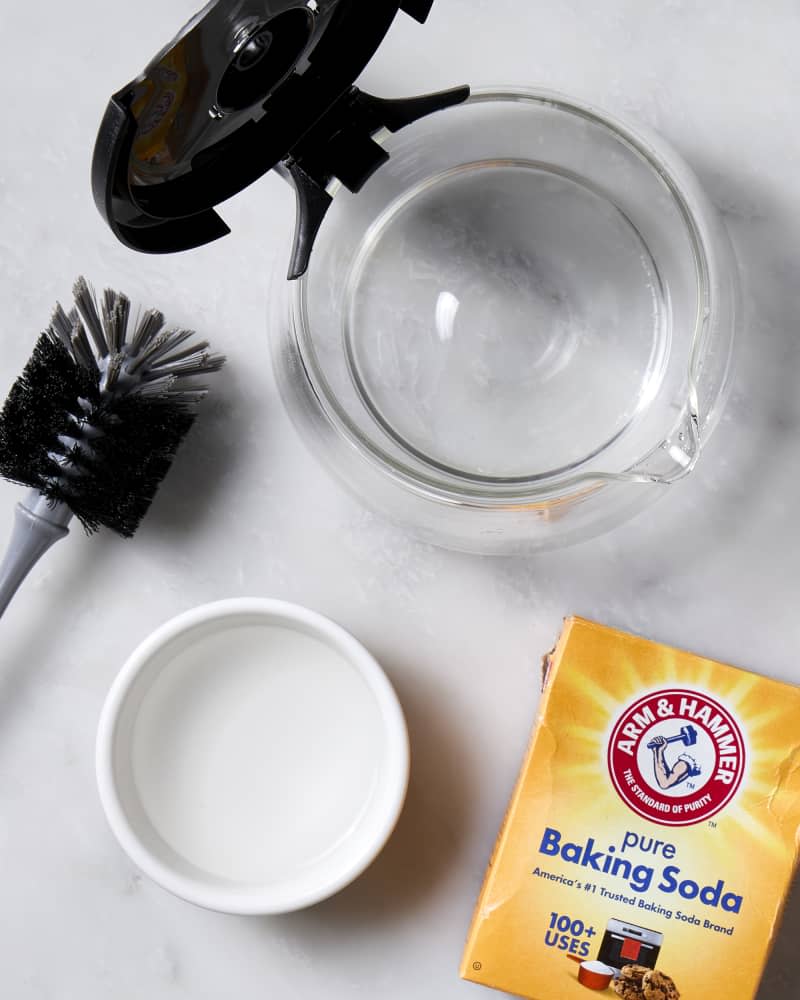
Coffee Pot Cleaning Method: Baking Soda Paste
Ease of use: 3.5/5
Performance: 4.5/5
Total time: 4.5/5
Overall: 4.5/5
The method: Sprinkle a little bit of baking soda onto the bottom of your stained carafe, and add just enough water to form a paste, then scrub with a bottle brush. After a minute or so of scrubbing, rinse out the pot. (It also works on stained Chemex coffeemakers.)
How it went: I loved this method! I always have baking soda on hand, and this method worked almost instantly. I love that it only requires baking soda and water, and doesn’t waste produce, salt, water — or time. You definitely need to have a brush that fits into the nooks and crannies of the coffee pot with a plastic, wood, or rubber handle so it doesn’t break the glass (like this one). While it definitely took a little bit of light scrubbing to get it clean, I found the baking soda left the pot sparkling clean. I couldn’t recommend this method more highly!
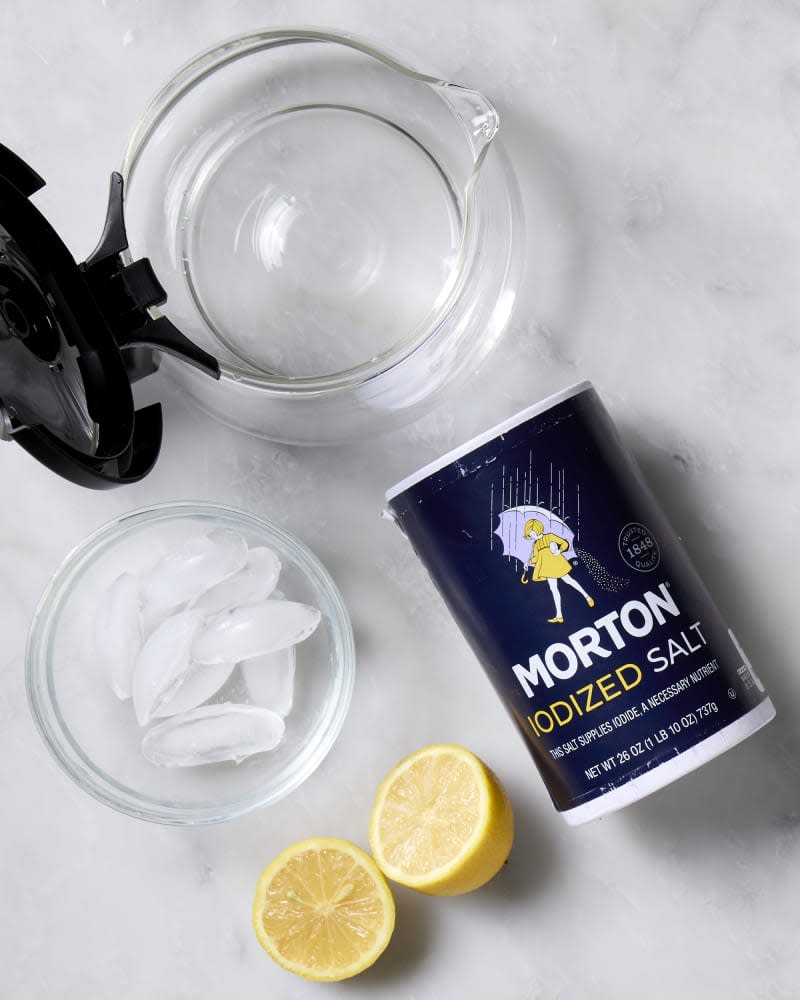
Coffee Pot Cleaning Method: Salt, Ice & Lemon
Ease of use: 4/5
Performance: 5/5
Total time: 4.5/5
Overall: 5/5
The method: Combine 3 tablespoons of salt, 2 tablespoons of fresh lemon juice, and 1 cup of crushed ice in your carafe. Swirl it around the sides for about a minute. Rinse with cold water and scrub any stubborn spots with a brush or sponge.
How it went: The entire method took me about 10 minutes total, with only about five minutes of active cleaning time. It’s important to note that I crushed the ice, which I did by putting my cubes in a quart-size bag and carefully smashing them with the bottom of my soap dispenser. (Of course, you could use a meat tenderizer or a rolling pin, but I didn’t have either on hand.) I was completely surprised by how well this method removed the coffee stains! It left my carafe sparkling — I mean, it really, really worked! No coffee residue was left behind, like none at all. I was so shocked because I’ve soaked my pot several times in just soapy water and never got results even close to this. Plus, there were no bad odors; my carafe smelled lemony and fresh! I’d definitely recommend this method and will use it again the next time my coffee pot needs a freshening. (I also have a pour-over coffee carafe with similar staining on the glass, and I’m excited to try his method on it to see if I can get the same results!).
Crushed ice seems very important to this method’s effectiveness. The jagged edges combined with the coarse salt helped scrape off that caked-on coffee residue, and I have a narrow opening in my carafe, so I couldn’t get my hand in there to really scrub. To make sure I gave it the best chance of working, I used a long wooden spoon to vigorously stir the mixture, bringing it right up to where I could see the stains. For any remaining spots, I put a sponge inside my carafe and used the wooden spoon to push the sponge against the glass and spot-scrubbed the stains, which quickly vanished. I imagine this would be easier if you could fit your hand inside your coffee pot, but even if you can’t, you can make this method work for you!
The Winning Method
First and foremost: It’s difficult to say which is the absolute best method because there were four different testers, and so method reviews were compared with a few tablespoons, err, grains of salt. But four of the five methods proved to be effective and were recommended by our testers, all with varying levels of effort, time, and residue left behind.
The salt-ice-lemon method tester simply had the most glowing review of her experience — including, most importantly, the fact that there was absolutely no residue or stains left behind after a quick 10-minute process. The crushed ice seemed to help get every inch of the coffee stains off of the inside of the carafe, and all three required ingredients are likely already in your pantry (and freezer), which is a huge plus. And the best part? It was easy!
Both the vinegar and dish soap, and the baking soda paste methods scored highly in almost every area, earning them 4 and 4.5 overall scores. The testers were happy with both of the methods, and they require only a few things you likely already have in your kitchen; the biggest con of the vinegar method was the overnight soaking, which requires no effort (and would be easy to do after your daily pot is done), but the tester did find that it was still effective even with less soaking time, which is promising if you don’t have all night.
Although they were relatively effective, affordable, and extremely easy to use, because the denture tablets might not already be in your medicine cabinet, it would be an unnecessary purchase, and didn’t get the coffee pot completely clean and clear, which is why it didn’t rank higher. It’s worth noting that crushed ice might have helped the salt-ice-vinegar method perform better, but you’re welcome to test that theory on your own — for now, with whole ice cubes, we’ll let the disappointment of our tester speak for itself.
All in all, nearly all of these methods could work to clean your cloudy, stained coffee pot depending on what you have on hand, how much time you’re willing to spend, and how dirty your coffee pot is. I call that a win-win-win-win-win!
Collette Reitz, Meg Asby, and Rebecca Walden contributed to the writing and research of this article.

